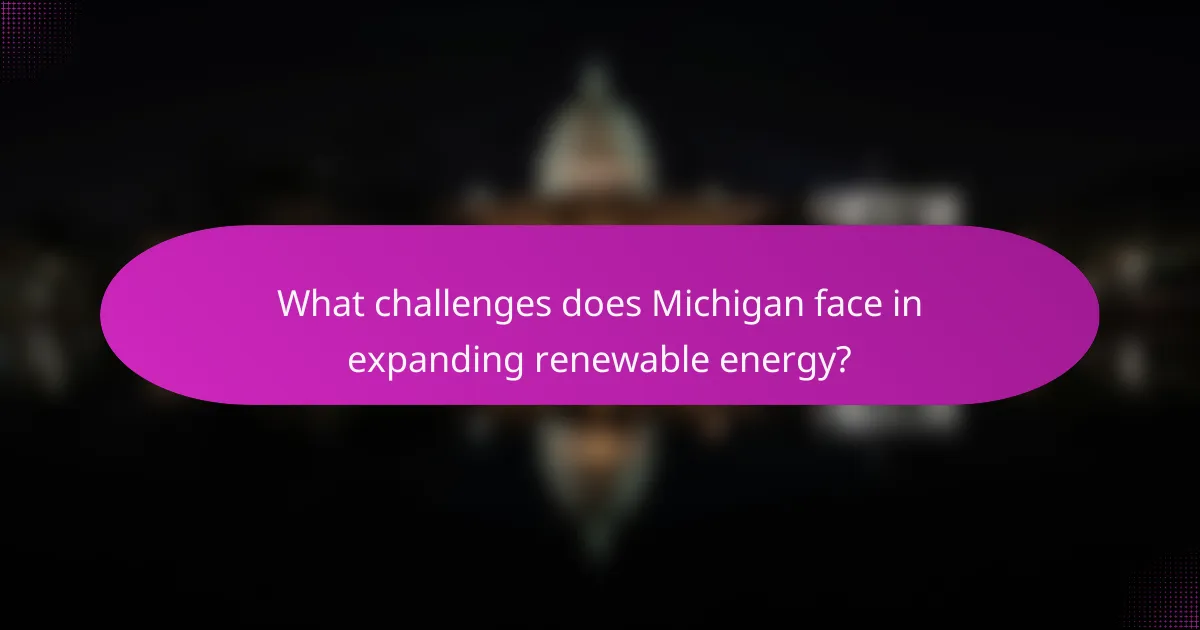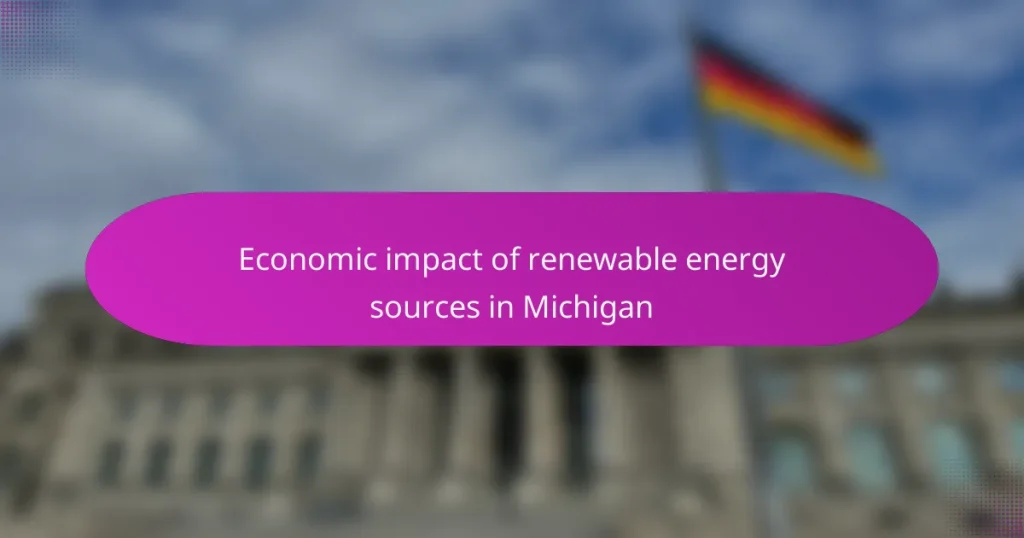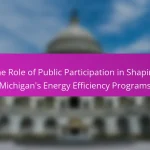
What is the economic impact of renewable energy sources in Michigan?
Renewable energy sources in Michigan significantly contribute to the state’s economy. They create jobs, stimulate local economies, and reduce energy costs. The renewable energy sector employs over 100,000 people in Michigan as of 2022. Wind and solar industries are the largest contributors to job growth. Investment in renewable energy reached approximately $2.5 billion in 2021. This investment supports infrastructure development and technological advancements. Additionally, renewable energy reduces reliance on fossil fuels, leading to lower energy prices for consumers. According to the Michigan Public Service Commission, renewable energy can save residents up to $2 billion by 2030. Overall, renewable energy sources enhance economic stability and sustainability in Michigan.
How do renewable energy sources contribute to Michigan’s economy?
Renewable energy sources significantly contribute to Michigan’s economy by creating jobs and stimulating local investment. The renewable energy sector employed over 85,000 people in Michigan as of 2020. This number is expected to grow as more projects are developed. Renewable energy also attracts investments, with over $3 billion invested in wind and solar projects in recent years. These investments enhance local economies by increasing tax revenues. Furthermore, renewable energy reduces dependence on fossil fuels, leading to lower energy costs for consumers. Michigan’s commitment to renewable energy can help diversify its economy and promote sustainable growth.
What are the primary renewable energy sources utilized in Michigan?
The primary renewable energy sources utilized in Michigan are wind, solar, and biomass. Wind energy is generated through numerous wind farms across the state. As of 2021, Michigan had over 1,200 megawatts of installed wind capacity. Solar energy is harnessed through both large-scale solar farms and residential installations. The state has seen a significant increase in solar capacity, reaching over 700 megawatts by 2021. Biomass energy is produced from organic materials, including agricultural waste and wood products. This source contributes to the state’s renewable energy portfolio, providing local energy solutions. Together, these sources play a crucial role in Michigan’s transition to cleaner energy.
How do these energy sources create jobs in the state?
Renewable energy sources create jobs in Michigan through the development, installation, and maintenance of energy systems. The growth of wind and solar industries requires skilled labor for manufacturing components. This includes jobs in factories that produce turbines and solar panels. Additionally, installation jobs are generated as new renewable energy projects are built across the state. The maintenance of these systems also demands ongoing employment for technicians and engineers. According to the Michigan Energy Innovation Business Council, the clean energy sector supports over 100,000 jobs statewide. This figure reflects the expanding workforce driven by renewable energy initiatives.
What are the financial benefits of renewable energy in Michigan?
Renewable energy in Michigan provides significant financial benefits. These benefits include job creation, reduced energy costs, and economic growth. The renewable energy sector has created over 100,000 jobs in Michigan. This includes positions in solar, wind, and energy efficiency industries. Additionally, renewable energy reduces reliance on imported fuels, which stabilizes energy prices. The Michigan Energy Innovation Business Council reported that renewable energy could save consumers up to $1 billion annually. Furthermore, investments in renewable energy attract new businesses and stimulate local economies. This leads to increased tax revenues for local governments. Overall, renewable energy contributes positively to Michigan’s economic landscape.
How does renewable energy reduce energy costs for consumers?
Renewable energy reduces energy costs for consumers by lowering electricity prices over time. The generation of renewable energy, such as wind and solar, has become increasingly cost-effective. According to the International Renewable Energy Agency, the cost of solar energy has dropped by 89% since 2009. Wind energy costs have also decreased significantly, making it a competitive alternative.
As more renewable energy sources are integrated into the grid, they reduce reliance on fossil fuels. This shift leads to lower fuel costs and less price volatility. In Michigan, renewable energy initiatives have resulted in savings on energy bills for households. The Michigan Public Service Commission reported that renewable energy programs could lead to lower rates for consumers in the long term.
In summary, renewable energy contributes to reduced energy costs through decreased generation expenses and enhanced price stability.
What incentives exist for businesses to invest in renewable energy?
Businesses can benefit from various incentives to invest in renewable energy. Tax credits are available, such as the Federal Investment Tax Credit (ITC), which allows businesses to deduct a significant percentage of their investment costs. Additionally, many states, including Michigan, offer specific tax incentives aimed at promoting renewable energy projects. Grants and rebates are also provided by both federal and state governments to offset the initial costs of renewable energy installations.
Furthermore, businesses may experience lower operational costs over time due to reduced energy expenses. Renewable energy sources often lead to increased energy independence and stability in energy prices. There are also potential marketing advantages, as consumers increasingly favor environmentally responsible companies.
According to the Michigan Energy Office, investments in renewable energy can lead to job creation and stimulate local economies. These incentives collectively encourage businesses to transition to renewable energy and contribute to a sustainable future.

How does renewable energy influence job creation in Michigan?
Renewable energy significantly influences job creation in Michigan. The sector has seen substantial growth due to investments in wind, solar, and energy efficiency projects. According to the Michigan Energy Innovation Business Council, the renewable energy industry supports over 100,000 jobs statewide. This includes roles in manufacturing, installation, and maintenance of renewable energy systems. The shift towards clean energy sources is expected to create even more job opportunities. A report by the U.S. Department of Energy indicates that transitioning to renewable energy can lead to a net increase in jobs compared to fossil fuel industries. Thus, renewable energy is a key driver of job growth in Michigan’s economy.
What types of jobs are generated by the renewable energy sector?
The renewable energy sector generates various types of jobs. These include positions in manufacturing, installation, and maintenance of renewable energy systems. Specific job roles encompass solar panel installers, wind turbine technicians, and energy efficiency auditors. Research indicates that Michigan has seen significant job growth in these areas. According to the Michigan Energy Innovation Business Council, the state has over 100,000 jobs in the clean energy sector. This includes roles in research and development, project management, and policy analysis. The sector also supports jobs in supply chain management and logistics. Overall, the renewable energy sector in Michigan contributes to a diverse job market focused on sustainability.
How do these jobs compare to those in traditional energy sectors?
Jobs in renewable energy sectors generally offer higher growth potential compared to traditional energy sectors. The renewable sector has seen a job growth rate of 11% from 2018 to 2020, while traditional energy jobs grew at a rate of only 1%. Renewable energy jobs often require advanced skills and education, leading to higher average salaries. According to the U.S. Bureau of Labor Statistics, solar and wind technicians earn around $50,000 annually, while coal miners earn approximately $45,000. Additionally, renewable energy jobs are more resilient during economic downturns, as seen during the COVID-19 pandemic when traditional energy jobs faced significant layoffs. This trend indicates that renewable energy jobs are not only growing faster but also providing more stability and better compensation compared to traditional energy jobs.
What skills are in demand in Michigan’s renewable energy workforce?
Skills in demand in Michigan’s renewable energy workforce include technical expertise in solar and wind energy systems. Proficiency in energy efficiency and management is also critical. Knowledge of regulatory standards and environmental compliance is necessary. Skills in project management and systems integration are increasingly sought after. Additionally, data analysis and software proficiency are valuable for optimizing energy solutions. According to the Michigan Energy Innovation Business Council, these skills align with the state’s goal to expand its renewable energy sector.
How does renewable energy affect local economies in Michigan?
Renewable energy positively affects local economies in Michigan. It creates jobs in manufacturing, installation, and maintenance of renewable energy systems. According to the Michigan Energy Innovation Business Council, the clean energy sector employed over 100,000 people in 2019. Local investments in renewable projects stimulate economic growth. These projects often lead to increased property values and tax revenues for local governments. Renewable energy also reduces energy costs for consumers and businesses in the long term. A study by the Michigan Public Service Commission found that renewable energy can lower electricity prices. Furthermore, communities with renewable energy projects often experience enhanced energy independence and resilience. Overall, the shift to renewable energy fosters sustainable economic development in Michigan.
What role do local governments play in promoting renewable energy projects?
Local governments play a crucial role in promoting renewable energy projects. They establish policies and regulations that support renewable energy development. Local governments can provide financial incentives, such as tax credits or grants, to encourage investments in renewable energy. They often facilitate community engagement and education about the benefits of renewable energy. Local governments can streamline permitting processes to reduce barriers for renewable energy projects. They may also collaborate with private sectors and non-profit organizations to enhance project viability. In Michigan, local governments have implemented initiatives to increase renewable energy use, contributing to job creation and economic growth. For example, the Michigan Energy Office supports local energy planning efforts to promote sustainable practices.
How does community involvement enhance renewable energy initiatives?
Community involvement enhances renewable energy initiatives by fostering local support and collaboration. Engaged communities are more likely to advocate for renewable projects. This support can lead to smoother project approvals and reduced opposition. Local participation often results in tailored solutions that meet specific community needs. According to a study by the National Renewable Energy Laboratory, community-based projects can increase project acceptance by up to 40%. Additionally, involving community members can create job opportunities, boosting the local economy. This economic benefit further solidifies community backing for renewable energy initiatives. Overall, active community participation is crucial for the successful implementation and sustainability of renewable energy projects.

What challenges does Michigan face in expanding renewable energy?
Michigan faces several challenges in expanding renewable energy. Key obstacles include regulatory hurdles, limited infrastructure, and financial constraints. The state’s energy policies can slow down the adoption of new technologies. Additionally, existing power grid limitations hinder the integration of renewable sources. Financial investment in renewable projects is often insufficient. Competition with traditional energy sources also poses a significant challenge. Furthermore, public perception and acceptance of renewable energy can impact development efforts. These factors collectively impede Michigan’s progress toward a more renewable energy future.
What are the regulatory hurdles for renewable energy projects in Michigan?
Renewable energy projects in Michigan face several regulatory hurdles. These include obtaining permits from multiple state and local agencies. The Michigan Public Service Commission regulates utility-scale projects, which can complicate approval processes. Zoning laws can also pose challenges, as local governments have authority over land use. Environmental assessments are required, adding time and complexity to project timelines. Additionally, interconnection agreements with utility companies can delay project implementation. Compliance with federal regulations further complicates the process. These factors collectively impact the feasibility and economic viability of renewable energy projects in the state.
How do these regulations impact investment in renewable energy?
Regulations significantly influence investment in renewable energy. They can create a stable environment for investors by providing incentives and subsidies. For instance, states that implement tax credits often see increased capital flow into renewable projects. In Michigan, the Renewable Portfolio Standard mandates a specific percentage of energy from renewable sources. This requirement encourages utility companies to invest in wind and solar projects. Additionally, regulations that streamline permitting processes reduce costs and timeframes for project development. According to the Michigan Public Service Commission, these regulations have led to a 50% increase in renewable energy capacity since 2015. Overall, supportive regulations enhance investor confidence and drive growth in the renewable energy sector.
What are the environmental concerns associated with renewable energy development?
Renewable energy development raises several environmental concerns. Land use changes can disrupt local ecosystems. For instance, large solar farms may require extensive land clearing. Wind turbines can pose threats to bird and bat populations. The production of renewable energy technologies can result in pollution and resource depletion. For example, mining for lithium used in batteries can harm ecosystems. Additionally, water usage for bioenergy crops can impact local water supplies. These concerns highlight the need for careful planning and management in renewable energy projects.
What strategies can Michigan adopt to overcome these challenges?
Michigan can adopt several strategies to overcome challenges related to renewable energy. First, increasing investment in renewable energy infrastructure is essential. This includes solar, wind, and biomass facilities. Second, implementing supportive policies and incentives can attract private investment. Tax credits and grants for renewable projects can significantly boost development. Third, enhancing workforce training programs is vital. Skilled workers are needed for installation and maintenance of renewable energy systems. Fourth, fostering partnerships between government and private sectors can drive innovation. Collaboration can lead to shared resources and expertise. Fifth, promoting public awareness and education on renewable energy benefits can increase community support. Engaging residents in sustainability initiatives can create a more favorable environment for renewable projects. These strategies are supported by the Michigan Energy Efficiency and Renewable Energy Resource Act, which aims to improve energy efficiency and expand renewable energy sources in the state.
How can public-private partnerships enhance renewable energy initiatives?
Public-private partnerships can enhance renewable energy initiatives by combining resources and expertise from both sectors. These collaborations facilitate investment in renewable technologies, making projects financially viable. They also streamline regulatory processes, expediting project approvals. For instance, in Michigan, partnerships between state agencies and private firms have led to significant advancements in wind and solar energy projects. According to a report by the Michigan Energy Innovation Business Council, such partnerships have resulted in over $1 billion in investments in renewable energy infrastructure. This collaborative approach fosters innovation and accelerates the transition to sustainable energy sources.
What role does education and awareness play in promoting renewable energy?
Education and awareness are crucial in promoting renewable energy. They inform individuals about the benefits of renewable sources. Increased knowledge can lead to greater public support for renewable initiatives. Awareness campaigns can influence policy decisions and funding for renewable projects. For example, studies show that states with strong educational programs see higher adoption rates of renewable technologies. In Michigan, educational initiatives have successfully engaged communities, leading to increased investment in solar and wind energy. This engagement results in job creation and economic growth. Therefore, education and awareness directly contribute to the expansion of renewable energy in Michigan.
What are best practices for maximizing the economic impact of renewable energy in Michigan?
Investing in local renewable energy projects maximizes economic impact in Michigan. Local projects create jobs and stimulate community economies. Utilizing state incentives can further enhance project viability. Collaboration with local governments ensures alignment with community needs. Engaging stakeholders increases public support and investment. Developing a skilled workforce is essential for long-term sustainability. Implementing energy efficiency measures complements renewable energy initiatives. Tracking economic metrics can guide future investments and improvements.
The main entity of this article is the economic impact of renewable energy sources in Michigan. The article outlines how renewable energy significantly contributes to the state’s economy by creating over 100,000 jobs, attracting approximately $2.5 billion in investments, and reducing energy costs for consumers. It details the primary renewable sources utilized in Michigan, including wind, solar, and biomass, and discusses the financial benefits, job creation, and local economic stimulation resulting from these energy initiatives. Additionally, it addresses the challenges Michigan faces in expanding renewable energy and suggests strategies for overcoming these obstacles.


